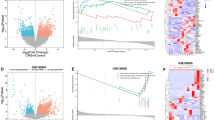Abstract
Objectives
The circRNAs–miRNAs–mRNAs competing endogenous RNA (ceRNA) networks involve in regulating the development of various inflammation-associated diseases, including allergic rhinitis (AR), and the present study aimed to identify novel AR-associated ceRNA networks.
Methods
The mRNA and protein levels of the associated genes were, respectively, examined by real-time qPCR and western blot analysis. The targeting sites in miR-556-5p and NLRP3 were validated by performing dual-luciferase reporter gene system assay. ELISA was used to measure inflammatory cytokines secretion, and CCK-8 assay was conducted to determine cell proliferation.
Results
Here, we first identified a hsa_circ_0000520/miR-556-5p/NLRP3 signaling cascade triggered epithelium pyroptosis and inflammation to regulate the development of AR in cellular and mice models. Specifically, the pyroptosis-associated biomarkers (NLRP3, ASC, IL-1β and IL-18) and pro-inflammatory cytokines (OVA-specific IgE, TNF-α, IL-4 and IL-5) were upregulated in the nasal subjects collected from AR patients and ovalbumin (OVA)-induced AR mice models, compared to their normal counterparts. Next, using the ceRNA networks analysis software, we screened out a hsa_circ_0000520/miR-556-5p axis that potentially regulated NLRP3 in the human nasal epithelial cell line. Mechanistically, miR-556-5p targeted both hsa_circ_0000520 and 3′ untranslated region (3′UTR) of NLRP3, and knock-down of hsa_circ_0000520 inactivated NLRP3-mediated epithelium pyroptosis through miR-556-5p in a ceRNA-dependent manner. Furthermore, we proved that both hsa_circ_0000520 ablation and miR-556-5p overexpression suppressed NLRP3-mediated cell pyroptosis to attenuate AR in mice models.
Conclusions
Taken together, we evidenced that targeting the hsa_circ_0000520/miR-556-5p/NLRP3 signaling pathway was a novel AQ1strategy to ameliorate AR progression; however, future clinical data are still required to validate our preliminary results.





Similar content being viewed by others

Data availability
All the data had been included in the manuscript, and the original data could be obtained from the corresponding author upon reasonable request.
Abbreviations
- AR:
-
Allergic rhinitis
- OVA:
-
Ovalbumin
- ceRNA:
-
Competing endogenous RNA
- 3′UTR:
-
3′ Untranslated region
- NLRP3:
-
NLR family pyrin domain containing 3
- Ox-LDL:
-
Oxidative low-density lipoprotein
- HUVECs:
-
Human umbilical vein endothelial cells
- CircRNA:
-
Circular RNA
- miRNA:
-
MicroRNA
References
Greiner AN, Hellings PW, Rotiroti G, Scadding GK. Allergic rhinitis. Lancet. 2011;378(9809):2112–22.
Kakli HA, Riley TD. Allergic rhinitis. Prim Care. 2016;43(3):465–75.
Bousquet J, et al. Next-generation Allergic Rhinitis and Its Impact on Asthma (ARIA) guidelines for allergic rhinitis based on Grading of Recommendations Assessment, Development and Evaluation (GRADE) and real-world evidence. J Allergy Clin Immunol. 2020;145(1):70-80.e3.
Schuler Iv CF, Montejo JM. Allergic rhinitis in children and adolescents. Pediatr Clin N Am. 2019;66(5):981–93.
Bernstein DI, Schwartz G, Bernstein JA. Allergic rhinitis: mechanisms and treatment. Immunol Allergy Clin N Am. 2016;36(2):261–78.
Sur DK, Plesa ML. Treatment of allergic rhinitis. Am Fam Phys. 2015;92(11):985–92.
Samitas K, Carter A, Kariyawasam HH, Xanthou G. Upper and lower airway remodelling mechanisms in asthma, allergic rhinitis and chronic rhinosinusitis: the one airway concept revisited. Allergy. 2018;73(5):993–1002.
Xiao L, Jiang L, Hu Q, Li Y. MicroRNA-133b ameliorates allergic inflammation and symptom in murine model of allergic rhinitis by targeting Nlrp3. Cell Physiol Biochem. 2017;42(3):901–12.
Yang Z, et al. NLRP3 inflammasome activation promotes the development of allergic rhinitis via epithelium pyroptosis. Biochem Biophys Res Commun. 2020;522(1):61–7.
Cui X, Guo Y, Wang Q, Li X. MiR-199-3p-Dnmt3a-STAT3 signalling pathway in ovalbumin-induced allergic rhinitis. Exp Physiol. 2019;104(8):1286–95.
Dissanayake E, Inoue Y. MicroRNAs in allergic disease. Curr Allergy Asthma Rep. 2016;16(9):67.
Liu HC, Liao Y, Liu CQ. miR-487b mitigates allergic rhinitis through inhibition of the IL-33/ST2 signaling pathway. Eur Rev Med Pharmacol Sci. 2018;22(23):8076–83.
Wang J, et al. MiR-146a mimic attenuates murine allergic rhinitis by downregulating TLR4/TRAF6/NF-κB pathway. Immunotherapy. 2019;11(13):1095–105.
Wang L, Liu X, Song X, Dong L, Liu D. MiR-202-5p promotes M2 polarization in allergic rhinitis by targeting MATN2. Int Arch Allergy Immunol. 2019;178(2):119–27.
Wang L, Lv Q, Song X, Jiang K, Zhang J. ADRB2 suppresses IL-13-induced allergic rhinitis inflammatory cytokine regulated by miR-15a-5p. Hum Cell. 2019;32(3):306–15.
Hu Z, et al. Protective effects of microRNA-22-3p against retinal pigment epithelial inflammatory damage by targeting NLRP3 inflammasome. J Cell Physiol. 2019;234(10):18849–57.
Xue Z, et al. miR-21 promotes NLRP3 inflammasome activation to mediate pyroptosis and endotoxic shock. Cell Death Dis. 2019;10(6):461.
Ying Y, Mao Y, Yao M. NLRP3 inflammasome activation by microRNA-495 promoter methylation may contribute to the progression of acute lung injury. Mol Ther Nucleic Acids. 2019;18:801–14.
Zhang Y, et al. SNHG1/miR-556-5p/TCF12 feedback loop enhances the tumorigenesis of meningioma through Wnt signaling pathway. J Cell Biochem. 2020;121(2):1880–9.
Zhao W, Cao L, Zeng S, Qin H, Men T. Upregulation of miR-556-5p promoted prostate cancer cell proliferation by suppressing PPP2R2A expression. Biomed Pharmacother. 2015;75:142–7.
Navarro-Quiroz E, et al. High-throughput sequencing reveals circulating miRNAs as potential biomarkers of kidney damage in patients with systemic lupus erythematosus. PLoS One. 2016;11(11):e0166202.
Lu Y, et al. SNHG1 inhibits ox-LDL-induced inflammatory response and apoptosis of HUVECs via up-regulating GNAI2 and PCBP1. Front Pharmacol. 2020;11:703.
Liu S, Xie X, Lei H, Zou B, Xie L. Identification of key circRNAs/lncRNAs/miRNAs/mRNAs and pathways in preeclampsia using bioinformatics analysis. Med Sci Monit. 2019;25:1679–93.
Wei DM, et al. Potential ceRNA networks involved in autophagy suppression of pancreatic cancer caused by chloroquine diphosphate: a study based on differentially-expressed circRNAs, lncRNAs, miRNAs and mRNAs. Int J Oncol. 2019;54(2):600–26.
Zhu J, et al. lncRNA/circRNA–miRNA–mRNA ceRNA network in lumbar intervertebral disc degeneration. Mol Med Rep. 2019;20(4):3160–74.
Bao X, et al. Characteristics of circular RNA expression of pulmonary macrophages in mice with sepsis-induced acute lung injury. J Cell Mol Med. 2019;23(10):7111–5.
Lin T, Zhang X, Lu Y, Gong L. Identification of circular RNA related to inflammation-induced lymphangiogenesis by microarray analysis. DNA Cell Biol. 2019;38(8):887–94.
Zhang Z, et al. circARF3 alleviates mitophagy-mediated inflammation by targeting miR-103/TRAF3 in mouse adipose tissue. Mol Ther Nucleic Acids. 2019;14:192–203.
Liu J, Cao Z. Protective effect of circular RNA (CircRNA) Ddx17 in ovalbumin (OVA)-induced allergic rhinitis (AR) mice. Med Sci Monit. 2020;26:e919083.
Shang X, et al. Comprehensive circular RNA profiling reveals that hsa_circ_0005075, a new circular RNA biomarker, is involved in hepatocellular crcinoma development. Medicine (Baltimore). 2016;95(22):e3811.
Sun H, et al. Hsa_circ_0000520, a potential new circular RNA biomarker, is involved in gastric carcinoma. Cancer Biomark. 2018;21(2):299–306.
Zang H, Li Y, Zhang X, Huang G. Blocking circ_0000520 suppressed breast cancer cell growth, migration and invasion partially via miR-1296/SP1 axis both in vitro and in vivo. Cancer Manag Res. 2020;12:7783–95.
Zhang J, Cai R, Zhang Y, Wang X. Involvement of a novel circularRNA, hsa_circ_0000520, attenuates tumorigenesis of cervical cancer cell through competitively binding with miR-146b-3p. J Cell Mol Med. 2020;24(15):8480–90.
Lv X, et al. hsa_circ_0000520 influences herceptin resistance in gastric cancer cells through PI3K-Akt signaling pathway. J Clin Lab Anal. 2020;2020:e23449.
Hu W, et al. Der p2–A20 DNA vaccine attenuates allergic inflammation in mice with allergic rhinitis. Mol Med Rep. 2019;20(6):4925–32.
Piao CH, Song CH, Lee EJ, Chai OH. Saikosaponin A ameliorates nasal inflammation by suppressing IL-6/ROR-γt/STAT3/IL-17/NF-κB pathway in OVA-induced allergic rhinitis. Chem Biol Interact. 2020;315:108874.
Watts AM, Cripps AW, West NP, Cox AJ. Modulation of allergic inflammation in the nasal mucosa of allergic rhinitis sufferers with topical pharmaceutical agents. Front Pharmacol. 2019;10:294.
Balci-Peynircioglu B, Akkaya-Ulum YZ, Akbaba TH, Tavukcuoglu Z. Potential of miRNAs to predict and treat inflammation from the perspective of Familial Mediterranean Fever. Inflamm Res. 2019;68(11):905–13.
Lu Q, Wu R, Zhao M, Garcia-Gomez A, Ballestar E. miRNAs as therapeutic targets in inflammatory disease. Trends Pharmacol Sci. 2019;40(11):853–65.
Funding
This study was financially supported by Shengjing Hospital of China Medical University.
Author information
Authors and Affiliations
Contributions
XY conducted most of the experiments, and was responsible for conception and manuscript drafting. MW and HZ provided technical support, and they helped to collect and analyze the data. ZC was the corresponding author who provided guidance for this work. Also, ZC proofread the manuscript and acquired funding to financially support this work.
Corresponding author
Ethics declarations
Conflict of interest
The authors declare that they have no competing interests.
Ethics approval and consent to participate
All the clinical experiments were conducted in accordance with the Declaration of Helsinki, and were approved by the Ethics Committee of the Shengjing Hospital of China Medical University. Also, all the participants had signed the informed consent forms. In addition, all the animal experiments were approved by the Ethics Committee of of the Shengjing Hospital of China Medical University.
Consent to publish
All the co-authors agreed to publish the final version of this manuscript.
Additional information
Responsible Editor: John Di Battista.
Publisher's Note
Springer Nature remains neutral with regard to jurisdictional claims in published maps and institutional affiliations.
Supplementary Information
Below is the link to the electronic supplementary material.

Figure S1.
The (A) hsa_circ_0000520 overexpression vectors, (B) miR-556-5p mimic and inhibitor were transfected into RPMI2650 cells, respectively. **P < 0.01. (JPG 213 KB)

Figure S2.
The (A) hsa_circ_0000520 overexpression vectors, (B) miR-556-5p mimic and inhibitor were delivered into AR mice models, respectively. **P < 0.01. (JPG 230 KB)

11_2021_1472_MOESM3_ESM.jpg
Figure S3. Real-Time qPCR was performed to examine IL-4 and IL-5 mRNA levels in the mice nasal mucosal tissues. *P < 0.05. (JPG 127 KB)
Rights and permissions
About this article
Cite this article
Yu, X., Wang, M., Zhao, H. et al. Targeting a novel hsa_circ_0000520/miR-556-5p/NLRP3 pathway-mediated cell pyroptosis and inflammation attenuates ovalbumin (OVA)-induced allergic rhinitis (AR) in mice models. Inflamm. Res. 70, 719–729 (2021). https://doi.org/10.1007/s00011-021-01472-z
Received:
Revised:
Accepted:
Published:
Issue Date:
DOI: https://doi.org/10.1007/s00011-021-01472-z



